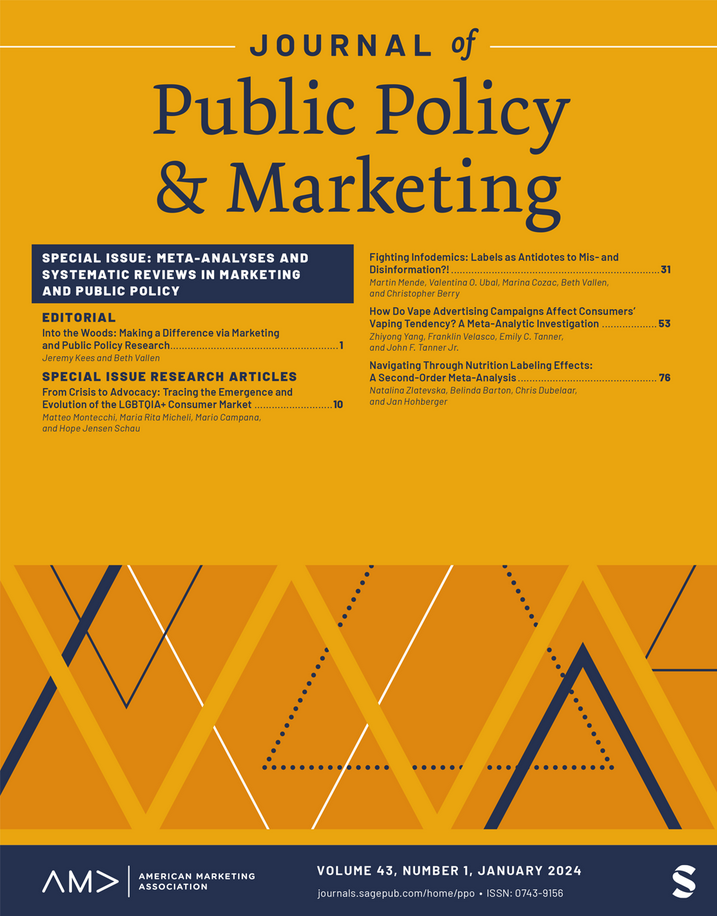Scarcity and Coronavirus
IF 4.7
3区 管理学
Q1 BUSINESS
引用次数: 38
Abstract
In March 2020, when COVID-19 was labeled a pandemic by the World Health Organization, store shelves were emptied of hand sanitizer, disinfectant wipes, and toilet paper. Newspaper headlines documented shortages of these products and announced closures of nonessential businesses. Restaurants, hotels, department stores, and childcare centers temporarily closed their doors, leaving many hourly workers unemployed. Without regular paychecks coming in, resources became scarce for many families. Within a matter of weeks, COVID-19 had caused widespread scarcity—scarcity of products, scarcity of services, and scarcity of resources—for millions of consumers all over the world. Clearly, the effects of such widespread scarcity of products, services, and resources will be long-lasting and complex. Although the COVID-19 crisis is itself unprecedented, there are several valuable insights we can draw from prior research on scarcity to understand consumers’ reactions to the crisis and potentially inform policy developed in response to the crisis. In the following sections, I highlight findings from prior research, discuss how they inform public policy, and propose ideas for future research. How do consumers react to scarcity, and do their immediate reactions differ from their longer-term reactions? Scarcity of either products or resources quickly attracts our attention (Mullainathan and Shafir 2013). Indeed, scarcity is often used by marketers to make products seem more desirable, as in “exclusive” or “limited time only” offers (Cialdini 1993). Learning about the scarcity of hand sanitizer, disinfectant wipes, and toilet paper further increased demand for these products. Yet, later in the consumer journey, consumers may respond to scarcity by consuming products and resources more thoughtfully and creatively (Hamilton et al. 2019). Consumers forced to cook at home began sharing recipes online. Faced with shortages of N95 masks used by health care workers, people began fashioning their own masks using old T-shirts and sewing masks to donate to first responders. From a marketing perspective, the substitutions prompted by scarcity of products, services, and resources may have longterm effects on consumer habits, behavior, and brand loyalty. Scarcity prompts substitution in both consumption and production processes (Hamilton et al. 2014). Stockout of a favorite brand may prompt a consumer to try a new brand, establishing new loyalties. Closure of a health club may motivate consumers to establish new workout routines. With childcare facilities closed, parents substitute other resources, such as their own time, for the money usually spent on childcare. In all of these cases, substitution erodes loyalty to brands, products, and service providers; this erosion may be more severe due to the other changes in consumers’ daily habits and routines caused by COVID-19. Although many product and service scarcities created by COVID-19 are shared by consumers of high and low socioeconomic status (SES), there are also important differences. While online retailers eliminate the geographic restrictions of offline retail, they still restrict consumers based on access to credit and digital literacy. High-SES consumers may react to scarcity at their local stores by finding items online and stocking up, exacerbating scarcity, while those with less disposable income, less access to credit, and smaller living spaces cannot afford to hoard. Even mental resources are taxed by scarcity (Mullainathan and Shafir 2013). Low-SES consumers, whose resources are already strained, may find it more difficult to evaluate options and make effective substitutions. Scarcity experienced during the current pandemic may have a lasting effect on consumers, especially if it occurs during formative years. Experiencing (vs. not experiencing) chronic scarcity can foster different models of the self, or “socioeconomic cultures,” that continue to shape consumers’ responses (Markus and Conner 2013). Those with high SES tend to interpret agency as exerting control over the environment, whereas those with low SES interpret agency as actively adapting to the environment and bringing themselves into line with environmental forces (Markus and Conner 2013). For example, interviews with survivors of Hurricane Katrina in 2005 who left the area before the storm, who tended to have higher SES, emphasized the degree to which they had exercised independence and control by choosing to leave. In contrast, those who stayed in New Orleans during the storm, who tended to have lower SES, emphasized exerting strength in the face of a challenge and not giving up (Stephens et al. 2009). We may物资短缺和冠状病毒
2020年3月,当世界卫生组织将COVID-19列为大流行时,商店货架上的洗手液、消毒湿巾和卫生纸都被清空了。报纸头条记录了这些产品的短缺,并宣布关闭不必要的业务。餐馆、酒店、百货商店、儿童保育中心暂时关门,导致许多小时工失业。由于没有定期的工资收入,许多家庭的资源变得稀缺。在短短几周内,COVID-19就给全世界数百万消费者造成了广泛的短缺——产品短缺、服务短缺和资源短缺。显然,产品、服务和资源如此普遍稀缺的影响将是长期和复杂的。尽管COVID-19危机本身是前所未有的,但我们可以从先前的稀缺性研究中获得一些有价值的见解,以了解消费者对危机的反应,并可能为应对危机制定的政策提供信息。在下面的章节中,我将重点介绍先前研究的发现,讨论它们如何为公共政策提供信息,并为未来的研究提出想法。消费者对稀缺性有何反应?他们的即时反应与长期反应有何不同?产品或资源的稀缺性很快吸引了我们的注意力(Mullainathan and Shafir 2013)。事实上,稀缺性经常被营销人员用来使产品看起来更受欢迎,如“独家”或“限时”提供(Cialdini 1993)。了解到洗手液、消毒湿巾和卫生纸的短缺,进一步增加了对这些产品的需求。然而,在消费者旅程的后期,消费者可能会通过更周到和创造性地消费产品和资源来应对稀缺性(Hamilton et al. 2019)。被迫在家做饭的消费者开始在网上分享菜谱。面对医护人员使用的N95口罩短缺,人们开始用旧t恤和缝纫口罩制作自己的口罩,捐赠给急救人员。从市场营销的角度来看,由于产品、服务和资源的稀缺性而导致的替代可能会对消费者的习惯、行为和品牌忠诚度产生长期影响。稀缺性促使消费和生产过程中的替代(Hamilton et al. 2014)。最喜欢的品牌缺货可能会促使消费者尝试新品牌,建立新的忠诚度。健身俱乐部的关闭可能会促使消费者建立新的锻炼习惯。随着托儿设施的关闭,父母们用其他资源,比如他们自己的时间,来代替通常花在托儿上的钱。在所有这些情况下,替代都会侵蚀消费者对品牌、产品和服务提供商的忠诚度;由于新冠肺炎引起的消费者日常习惯和日常活动的其他变化,这种侵蚀可能会更加严重。尽管高社会经济地位和低社会经济地位的消费者共同面临着COVID-19造成的许多产品和服务短缺,但也存在重要差异。虽然在线零售商消除了线下零售的地理限制,但他们仍然根据获得信贷和数字素养来限制消费者。高ses消费者可能会对当地商店的稀缺做出反应,在网上寻找商品并囤积,这加剧了稀缺,而那些可支配收入较低、获得信贷渠道较少、居住空间较小的消费者则负担不起囤积。即使是精神资源也因稀缺性而受到限制(Mullainathan and Shafir 2013)。低社会经济地位的消费者,其资源已经紧张,可能会发现更难以评估选择,并作出有效的替代。在当前大流行期间经历的短缺可能会对消费者产生持久影响,特别是如果它发生在形成时期。经历(vs.不经历)长期稀缺可以培养不同的自我模式,或“社会经济文化”,继续塑造消费者的反应(Markus和Conner 2013)。高社会经济地位的人倾向于将代理解释为对环境的控制,而低社会经济地位的人则将代理解释为积极适应环境,使自己与环境力量保持一致(Markus and Conner 2013)。例如,在对2005年卡特里娜飓风幸存者的采访中,他们在风暴来临前离开了该地区,他们往往具有更高的社会经济地位,强调了他们通过选择离开来行使独立和控制的程度。相比之下,那些在风暴期间留在新奥尔良的人,他们的社会经济地位往往较低,他们强调在面对挑战时发挥力量,不放弃(Stephens et al. 2009)。我们可能
本文章由计算机程序翻译,如有差异,请以英文原文为准。
求助全文
约1分钟内获得全文
求助全文
来源期刊

Journal of Public Policy & Marketing
BUSINESS-
CiteScore
10.20
自引率
15.40%
发文量
29
期刊介绍:
Journal of Public Policy & Marketing welcomes manuscripts from diverse disciplines to offer a range of perspectives. We encourage submissions from individuals with varied backgrounds, such as marketing, communications, economics, consumer affairs, law, public policy, sociology, psychology, anthropology, or philosophy. The journal prioritizes well-documented, well-reasoned, balanced, and relevant manuscripts, regardless of the author's field of expertise.
 求助内容:
求助内容: 应助结果提醒方式:
应助结果提醒方式:


